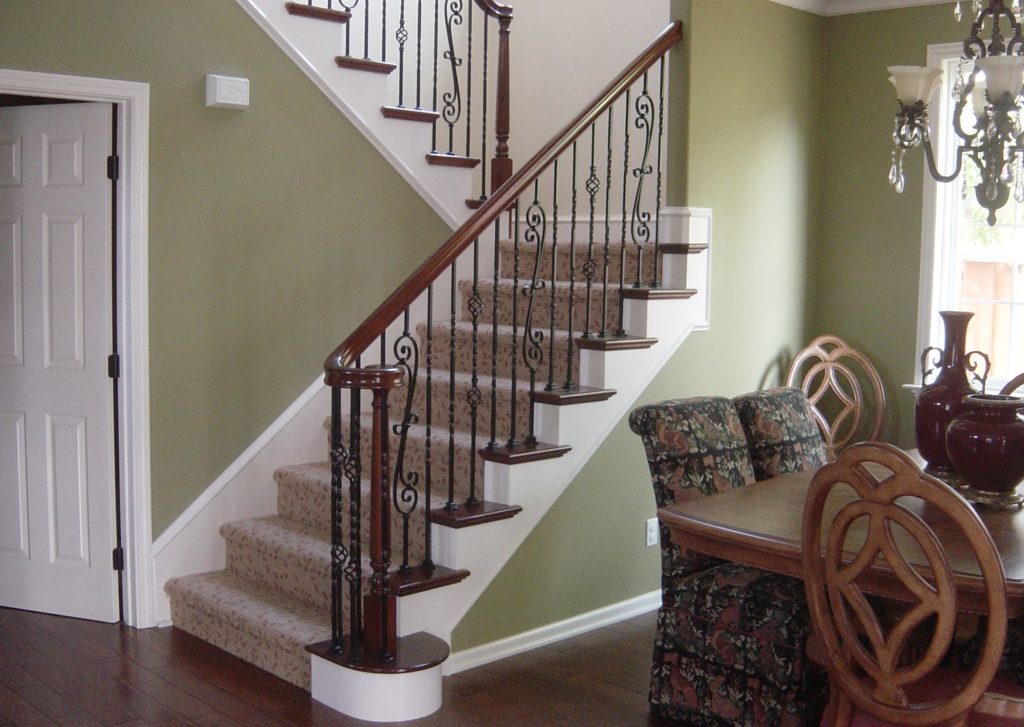
A remodeled staircase can have a surprising aesthetic impact. Photo: Martinez Stair Company Inc. ©2019
A staircase is essentially a practical fixture, but as the home’s central architectural element, it also has the ability to tie things together aesthetically. Perhaps that’s why many homeowners choose to remodel their staircases in conjunction with other home renovation projects. In this article, we’ll take a glimpse into the niche trade of stairs remodeling.
Why remodel stairs?
Homeowners choose to remodel their stairs for a variety of reasons, the most common of which is aesthetic improvement. A lot of staircases built during the 1970s, ’80s, and ’90s feature elements and detail work that are considered passé by today’s standards. That’s why most stairs remodeling projects consist of replacing outdated handrails, newel posts, balusters and other components with ones that have modern designs. Additionally, if the home’s flooring has been replaced, the homeowner will likely want to replace the steps (aka stair treads) with a similar material to match.
Another factor that motivates some homeowners to remodel their stairs is safety. Many older staircases don’t conform to the high safety standards of modern building code, which can be especially concerning for homeowners with young children or senior citizens who are “aging in place.” Furthermore, a staircase can start to sag or become structurally unsound over time, a condition evinced by signs such as squeaky or misaligned steps. Stairs remodeling provides an opportunity to bring a staircase up to current safety standards and repair any structural deficiencies.
What’s the current trend in stairs remodeling?
According to Taro Martinez of Martinez Stair Company Inc., homeowners are ditching the fashions of the latter 20th century in favor of a contemporary aesthetic. “Many retro staircases have a lot of metal or dark woods like oak, which is what most of my clients want to get away from,” he explains. “These days, I’m doing a lot of contemporary staircase designs, characterized by straight, clean lines and minimal architectural detail. Rectangular newel posts and handrails are a popular choice, along with plain, round metal balusters installed vertically or horizontally.”
What is the typical cost and timeline of a stairs remodeling project?
Not surprisingly, the cost and timeline involved in remodeling a staircase can vary substantially. “Depending on its size and scope, a stairs remodeling project can cost between $3,000 and $10,000 and take anywhere from two weeks to two months to complete,” estimates Mr. Martinez. “That’s a pretty wide gamut, but as with any project, there are many aspects to factor in, such as the materials being used and whether structural reframing is needed.”
Why hire a stairs contracting specialist instead of a general contractor?
The simple answer is that most general contractors would do the same themselves. “Most general contractors won’t work on stairs,” affirms Mr. Martinez. “Even if they employ their own crews and prefer to handle most jobs in-house, they’ll generally do everything but stairs.”
So, why don’t general contractors want to deal with stairs? “As far as finish carpentry goes, stairs are at the top of the trade,” says Mr. Martinez. “Nobody wants to do handrails—they’re extremely complicated. Plus, you have to factor in safety requirements. For example, handrails must be between 34 inches and 38 inches in height, and there can be no more than a four-inch space anywhere in the staircase.”
Additionally, Mr. Martinez says stairs remodeling requires a lot of creative problem-solving, which is where a specialist’s expertise can really pay off. “Every staircase has some kind of anomaly. Whether it has to do with the railing, the steps or the structure, there’s always something unique that needs to be figured out. That’s why you need a stairs contractor who can get creative and engineer custom solutions to these custom problems.”
